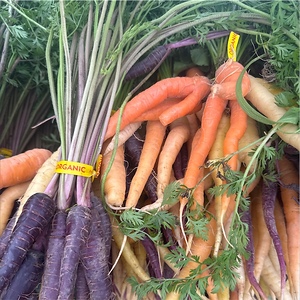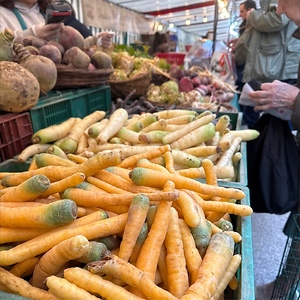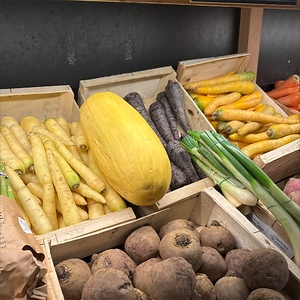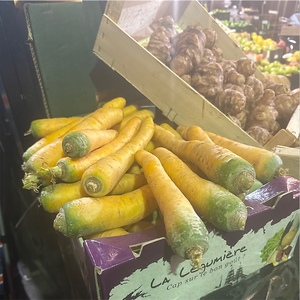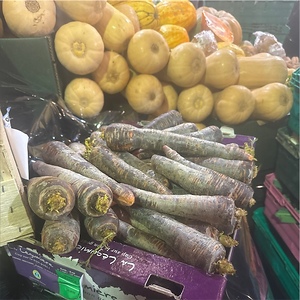


Heritage Carrots
Estimated Inventory, lb : 0
Description/Taste
Heritage carrots vary in appearance, depending on the variety and age at harvest, and can be found in small to large sizes. The roots are generally uniform in shape, featuring a slender conical nature beginning with sloping, curved shoulders and tapering to a narrow, blunt, or pointed tip. The roots are also typically sold without leafy green tops, but this is up to the vendor's discretion. The skin is firm and semi-smooth, often covered in faint horizontal lines, striations, and root hairs. Multiple varieties are sold under the Heritage carrot name, allowing the roots to appear in shades of red, orange, purple, yellow, and white. Underneath the surface, the flesh is dense, solid, crisp, and chewy. The flesh also generally matches the root’s exterior color, but some cores may be white instead of colored. Heritage carrots are edible raw or cooked, and only roots that are brightly colored, fresh, and without cracks should be selected. The carrots range in flavor, depending on the specific type, and will have mild, subtly sweet, and delicate flavors to an earthy sweetness with some minerality.
Seasons/Availability
Heritage carrots are available year-round.
Current Facts
Heritage carrots, botanically classified as Daucus carota, are a specialty grouping of roots sold in commercial markets belonging to the Apiaceae family. The term heritage is commonly used in European markets, especially in England and France, and can be interchangeably used with the term heirloom, a preferred descriptor in North American markets. Heritage carrots are a marketing method for traditional carrot varieties being grown by specialty producers. Many varieties of carrots are sold under the broad heritage name, and these bunches can include a spectrum of colors harvested in their baby or full-grown stage. In fresh markets, Heritage carrots are positioned as varieties of cultural importance, and most types sold under this name have been grown for at least 50 to 100 years through generations of seed saving. Consumers value Heritage carrots for their diversity, colors, and stronger flavor over other commercial varieties grown in bulk. Heritage carrots are sought by chefs and home cooks for their versatility and are prepared fresh or cooked in a wide array of savory and sweet culinary dishes.
Nutritional Value
Heritage carrots are a source of fiber to support digestive health and potassium to balance fluid levels within the body while replenishing electrolytes. They also provide manganese to aid the body in normal cognitive functions, vitamin C to strengthen the immune system, vitamin K to aid in faster wound healing, and beta-carotene, which is converted into vitamin A in the body to maintain healthy organs and promote eye health. It is important to note that each variety sold under the heritage name will have varying nutritional properties. Orange carrots are known for their beta-carotene content, while yellow carrots have high concentrations of lutein and xanthophyll. Purple carrots contain anthocyanins, and red carrots contain lycopene, which both have antioxidant properties to reduce inflammation and guard the cells against free radical damage. Beyond vitamins and minerals, carrot seeds were once used in medicinal remedies involving digestion issues. The natural pigment sourced from purple carrots was also used as an ancient fabric dye.
Applications
Heritage carrots have sweet and earthy flavors suited for fresh and cooked preparations. These carrots can be utilized in any preparation calling for carrots, in general, and are no different from other commercial types in recipes. Heritage carrots can be washed, peeled, and served raw in salads or ribboned and tossed in a vinaigrette as a fresh dish. The roots can also be served on crudité plates, shredded into slaws, or pressed into a refreshing juice. In addition to raw preparations, Heritage carrots are popularly stir-fried, roasted, steamed, boiled, or braised. It is worth noting that purple carrots will leach their coloring into dishes and may turn brown, depending on the preparation. Heritage carrots are famously known for roasting and are often cooked with ingredients like honey, maple, miso, balsamic, or yogurt for enhanced flavoring. The carrots can also be cooked with other root vegetables or blended into purees and dips to alter their texture. In Europe, Heritage carrots are cooked confit or grilled for a smokey flavor. They are also simmered into soups and stews or cooked into risotto, casseroles, and savory pies. Some of the earliest known carrot recipes involved stuffing larger-sized carrots with meat. Heritage carrots can also be used to enhance sweetness in dishes. The roots are incorporated into variations of cookies, muffins, and cakes or added to puddings and custards. For extended use, try pickling carrots for a tangy condiment or addition to savory main dishes. Carrot top leaves are also edible and should be saved. The greens can be blended into variations of pesto for a fresh twist. Heritage carrots pair well with herbs such as mint, thyme, and coriander, nuts including pecans, pine, and almonds, oranges, cranberries, pomegranate, and spices such as cardamom, sumac, and star anise. Whole, unwashed carrots should be separated from their greens and stored in the refrigerator for 1 to 2 weeks. There are several suggested methods for storing carrots, from keeping them in water, wrapping them in paper towels, to storing sliced pieces in plastic bags.
Ethnic/Cultural Info
Heritage is widely used in British markets as a descriptor for specialty fruits and vegetables. The term resonates with the country’s history and culture and was once closely associated with heritage kitchen gardens in British home estates. Historically, these gardens were maintained to be visually appealing, and the vegetables grown on the property were known for having notable flavor to serve during meals and celebrations. Heritage was used to praise something culturally important and was maintained using traditional methods throughout England. As new commercial produce varieties were introduced into retail markets, retailers began separating varieties that were grown for mass production versus varieties that were grown for flavor and tradition. Varieties grown traditionally were labeled as heritage to acknowledge their importance. Heritage carrots are widely sold throughout British markets, and carrots, in general, are presently one of the most popular vegetables in England. The world’s longest carrot was also produced by a British grower. According to the Guinness Book of World Records, Joe Atherton grew the world’s longest carrot, measuring 6.245 meters in length. The carrot was documented at the United Kingdom Giant Vegetables Championship in Malvern, UK, in 2016, and Atherton broke his previous record set in 2007.
Geography/History
Carrots are descendants of wild species with origins in Central Asia. Early carrot types typically appeared in violet and white shades, later developing red and yellow hues. Much of the ancient history of carrots is unknown, but it is hypothesized that domestication of the wild species began sometime around 900 CE. Over time, new types of carrots were developed to create a fleshier and sweeter root. Carrots later spread in cultivation, expanding to areas of the Middle East, Europe, and East Asia. Throughout history, the roots were prepared in culinary preparations, and the seeds were sometimes used medicinally. Carrots were also valued for their easy-to-transport nature and extended storage capabilities, which led them to be carried on trips and migrations. By the 14th century, carrots were being grown throughout Europe, and by the 17th century, they had expanded in cultivation to parts of the Americas. Today, carrots are grown worldwide and are a common commercial product. Heritage carrots can be found worldwide but are primarily sold through farmer’s markets, select grocers, and retailers in Europe.



